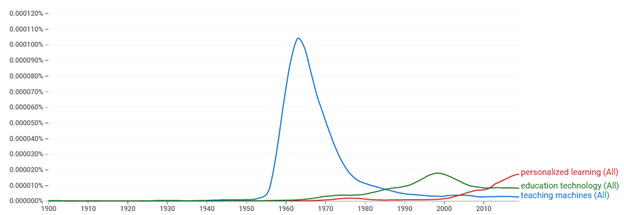My introductory psychology course has just a few slides devoted to B. F. Skinner – the public intellectual of mid-century psychology. He is probably best known for being the face of the behaviorist tradition in psychology, and in particular operant conditioning principles. That is, until the cognitive revolution dethroned behaviorism as the dominant psychological tradition beginning in the 1980s.
But, as I’ve learned from Teaching Machines: The History of Personalized Learning by Audrey Watters, there is much more to the man and his role in education than I had previously realized. And this book is another great example of how limited the university psychology curriculum is regarding the teaching of the history of our field.
Watters’ Teaching Machines is centered on Skinner as a key public player in the teaching machines industry that ballooned in mid-century American classrooms. Although teaching (testing) machines were first championed by Sidney Pressy in the 1920s, Skinner championed his own teaching machine inventions in a much more public way, relentlessly working to bring the machines to mass market throughout the 1950s and 1960s.
These teaching machines were designed around several core learning principles that are rooted in the behaviorist tradition, including breaking down problems into their smallest possible part, providing students with immediate feedback, and giving ample positive reinforcement. Do any of these ideas sound familiar?
The push to integrate teaching machines and, more generally, technology into the classroom was reflective of a larger cultural shift during this era in which futuristic technologies were romanticized. Advocating for the ‘automatic teacher’ was the launching point for a vision in which education would be revolutionized by technology. Does this idea sound familiar?
While some argue that the teaching machines of the 1960s failed in their mission to revolutionize the classroom, they did not at all fail in having a lasting legacy. If one is to scratch the veneer of educations “new” ideas of today, you’ll see Skinner’s teaching machines in modern tech clothing. You’ll also notice that the narrative of “personalized learning” in which students work through material at their own pace on their own time is the very essence of what the educational future looked like in mid-century America.
Take a look at the Ngram below. You can see that teaching machines gained massive popularity in the 1950s and then fell out of favor in the 1980s when personal computers came along. Now, instead of teaching machines, we see the rise of education technology and computer aided instruction. Popular design in these new spaces include adaptive AI learning programs that break problems down into small parts, automatic grading that gives students immediate feedback, and the independent-from-teachers, self-paced learning design – do these ideas ring a bell?
The approach of modern education technology learning programs behold the core principles that teaching machines were designed around throughout the early and mid-20th century. In other words, the motivating ideas and essence of modern education technology is not new; it just leverages the phenomenal improvement of technology and computing that took off since the 1980s.
Teaching Machines provides a fascinating look at mid-century education reform centered on the use of technology in the classroom, and additionally provides far more context to the man that was B.F. Skinner than I would have known otherwise. That said, I expected more discussion about the connections between mid-century teaching machines and contemporary education technology, including the “new” philosophy of personalized learning that is currently sweeping through education. These connections are laid out clearly by Watters in the conclusion of her book, but I’m left wanting more. Hoping for a part 2?
Published: August 2021
Format: Hardcover
If you think this sounds interesting, bookmark these other great reads:
Failure to Disrupt: Why Technology Alone Can’t Transform Education by Justin Reich (2020)
The Amateur Hour: A History of College Teaching by Jonathan Zimmerman (2020)
Please note: this post contains affiliate links, allowing me to earn a small commission when you purchase books from the link provided. There is no cost to you, and this will allow me to keep this newsletter free and open to all. Happy reading!






